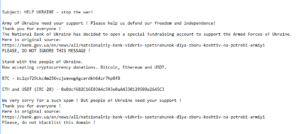What is “Army of Ukraine need your support” scam email
“Army of Ukraine need your support” scam email is an attempt by scammers and cybercriminals to make money during a time of crisis. The email encourages recipients to make donations to support the Ukrainian Armed Forces using the provided Bitcoin and Ethereum wallet addresses. But while the email does link to the legitimate National Bank of Ukraine website, the wallet addresses do not belong to them. The donations would go to scammers. This is just one of many scams currently going around, and if you want to make a donation, you need to be very vigilant and double-check the information before donating.
“Army of Ukraine need your support! Please help us defend our freedom and independence!” is how this particular email scam starts. It goes on to say that the National Bank of Ukraine has made the decision to open a fundraising account to support the armed forces. The latter is actually true and the information can be found on the official website for the National Bank of Ukraine. However, the email provides fake cryptocurrency wallet addresses to trick people into sending money to scammers. The mentioned cryptocurrency wallet addresses that belong to scammers are
bc1qv729ckc4m256vzjsmvwg4gcerdkh64zr7hp8f8 (Bitcoin) and 0x0dcf682C16E03A4c593e0aA4330129589a2645C3 (Ethereum and Tether). If you were to transfer cryptocurrency to these accounts, you would be sending it to scammers, not the Ukrainian Armed Forces. The email provides a link to the actual website for the National Bank of Ukraine in hopes that people will check that the information is real but not double-check how and to where they can donate.
It does not appear that anyone has fallen for this scam as of now, as the provided wallet addresses either do not have any transactions or they’re dated before Russia invaded Ukraine. Nonetheless, you need to be aware that a lot of cybercriminals are taking advantage of the situation and people’s good intentions to make money. If you decide to make a donation, do not trust random emails, social media posts, etc., to provide you with credible, donation-related information. Only trust legitimate sources, such as official websites for governments, charities, organizations, etc. And always double-check the information to make sure your money goes to where it’s supposed to. And keep in mind that there are many scams currently going around.
The “Army of Ukraine need your support” scam email is a prime example of how cybercriminals try to take advantage of crises and certain situations to scam and trick people. The same thing happened when the COVID-19 pandemic first began. Scammers started spamming people with emails about donating to healthcare facilities and organizations but provided incorrect donation options. It’s difficult to say how successful these types of scams are but hopefully, people are very careful about double-checking information before making donations.
If you have already made a transaction to dubious entities, you may be able to get your money back by contacting your bank and reporting the incident. Though if you transferred cryptocurrency, it’s not possible to get it back as cryptocurrency transactions are irreversible.
Site Disclaimer
WiperSoft.com is not sponsored, affiliated, linked to or owned by malware developers or distributors that are referred to in this article. The article does NOT endorse or promote malicious programs. The intention behind it is to present useful information that will help users to detect and eliminate malware from their computer by using WiperSoft and/or the manual removal guide.
The article should only be used for educational purposes. If you follow the instructions provided in the article, you agree to be bound by this disclaimer. We do not guarantee that the article will aid you in completely removing the malware from your PC. Malicious programs are constantly developing, which is why it is not always easy or possible to clean the computer by using only the manual removal guide.

